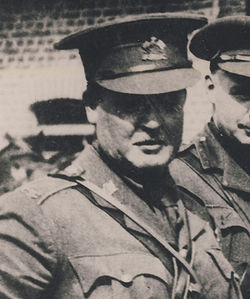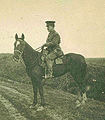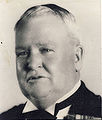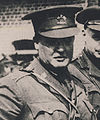Powers, Thomas Edward
| Thomas Edward Powers | |
|---|---|
| 7 September 1874 – 22 May 1952 | |
 | |
| Place of burial | Fairview Cemetery, Halifax |
| Allegiance | Canada |
| Service/branch | Canadian Army |
| Years of service | - 1935 |
| Rank | LCol |
| Commands held | 3rd Division Signal Company
Royal Canadian School of Signals |
| Awards | DSO, MiD |
Contents
Early Life
Attended the University of New Brunswick.
Service
Sergeant Powers was promoted provisional Lieutenant on 24 March 1904 and appointed as Signal Officer to Militia District No. 8.[2] As a Captain in 1906 (promoted 1 June 1906) he was appointed the Command Signaller for Maritime Command.[2] In 1911 came a reorganization of the Militia from 4 commands into 6 infantry divisions and 4 cavalry brigades and Captain Powers was appointed Signal Officer of No. 6 Division Headquarters.
Major 1 May 1914.
The then Major Powers served in the Canadian Militia before the war where he was the Commanding Officer of No. 7(?) Signal Company in Saint John New Brunswick.
Trained in Valcartier with the First Canadian Contingent with whom he served as Officer Commanding No. 1 (or 2) Section, 1st Canadian Divisional Signal Company. In December 1915, then serving as Company 2 i/c, he was selected to organize the formation of 3rd Canadian Divisional Signal Company with whom he served as Commanding Officer until December 1916.[2] For his service he was awarded the Distinguished Service Order.[3]
January 1917 found Major Powers' in poor health, like many of his division, ravaged and worn down by the effects of battle, gas and a steady onslaught of communicable diseases that spread throughout the trenches: mumps, pneumonia, dysentery, influenza as well as those spread by rats and lice. While hospitalized in London he received the Distinguished Service Order for his gallantry during the Second Battle of Ypres and subsequent engagements during his two years at the front. Given two months leave to recuperate from "trench fever", he returned to Canada to learn of his promotion to Lieutenant-Colonel.
As a Major, on 26 January 1917 he took over command of the CSC Headquarters Signalling School in Ottawa.[2] On 26 June 1917 he was granted the temporary rank of LtCol whilst performing the duties of Officer Commanding Signal Training Depot, Ottawa, Ont.[4]
After the war he was one of six officers initially brought on strength of the new permanent signalling corps.
In 1918 he continued to hold the temporary rank of LtCol and was appointed Officer Administering Royal Canadian Engineers and Railway, Construction, and Forestry Corps.[5]
Commanded the Royal Canadian School of Signals in Borden from 21 January 1931.
Retired 30 April 1935 as the senior serving Signals Officer in the Corps having been first appointed in 1904.
Retirement Years
In 1937, with Lt.-Col. S.C. Oland, as first commandant, Powers was instrumental in forming the Halifax division of the Canadian Corps of Commissionaires, serving as adjutant, vice-commandant and commanding officer. With the onset of the Second World War, he served as chief censor for the Port of Halifax, examining mail and other communications to ensure that military secrets did not fall into enemy hands.
Related Pages
Related Items
See Also
37th Signal Regiment Dinner Speech
References
- ↑ with information from http://thechronicleherald.ca/thegreatwar/1249605-lt-col-thomas-edward-powers
- ↑ 2.0 2.1 2.2 2.3 Semaphore to Satellite
- ↑ The London Gazette, Supplement 29886. 29 December, 1916. Page 29.
- ↑ General Order 72 of 1917.
- ↑ General Order 65 of 1918. 1st March, 1918.








